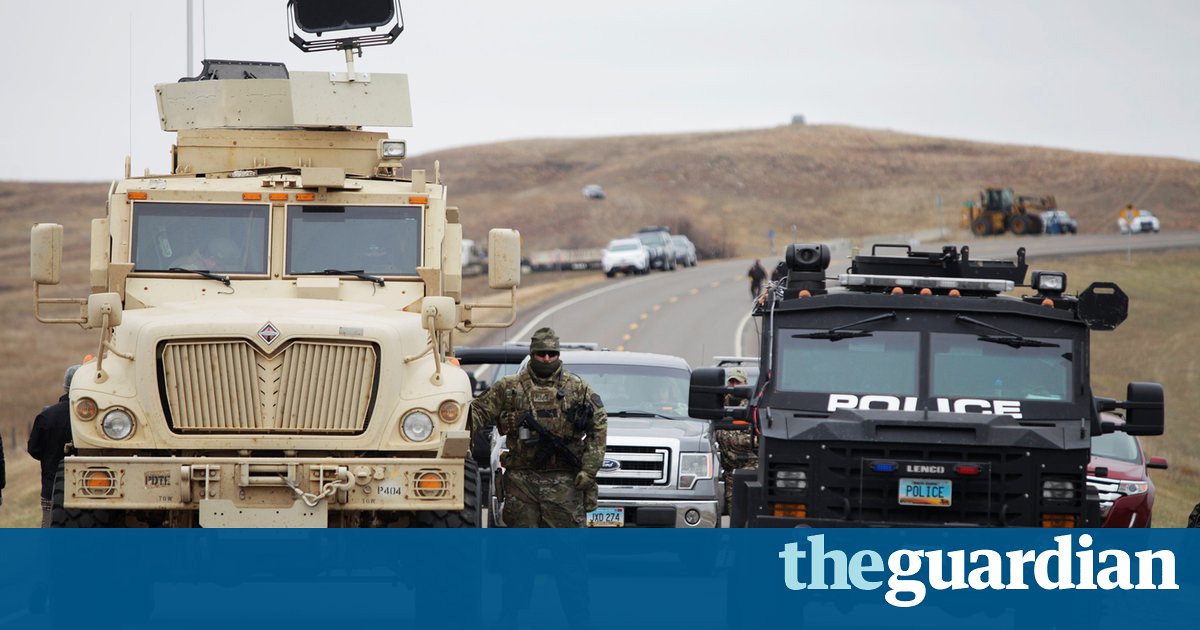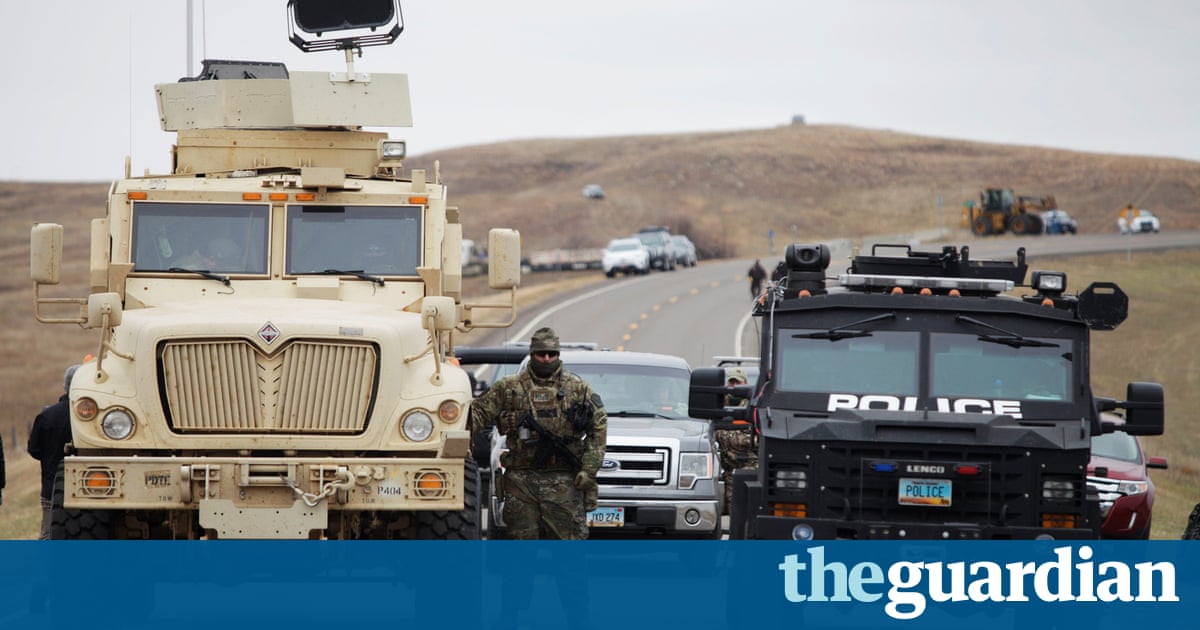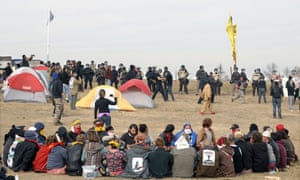Police ordered to arrest Dakota pipeline protesters and destroy bridge they built

Sheriffs office said police were in a standoff with protesters while activists say protesters were peaceful, raising concerns about more arrests and clashes

The US army corps of engineers ordered North Dakota police to arrest Native American protesters and destroy a bridge that activists built over a creek at the center of the increasingly tense Dakota Access pipeline demonstrations.
The Morton County sheriffs office announced on Wednesday that police were in a standoff with protesters on the banks of the Cantapeta Creek while activists said they were engaged in a peaceful water ceremony.
Police claimed that the protesters who have for months been attempting to block construction of the $3.8bn oil pipeline that they say threatens sacred lands and their water supply were trying to gain access to private property known as the Cannonball ranch. The group had built a handmade wooden pedestrian bridge across the creek, the sheriff said in a statement.
Officers responded and ordered protesters to remove themselves from the bridge and notified them that if they cross the bridge they would be arrested.
Police, who deployed pepper spray and teargas, said the activists were violating numerous federal and state laws, including the Clean Water Act and the Safe River and Harbors Act.
An army corps spokesman said the agency had given police permission to enter the federal property to prevent further campsites from developing and threatening public safety.
Protesters eventually retreated, and the sheriffs office said late Wednesday afternoon that police had arrested one individual who was aiding in illegal activity by purchasing canoes and kayaks to be used for crossing the waterway.
The activist, who police did not name, was arrested for conspiracy to commit obstruction of a government function.
Police also admitted to using less-than-lethal ammunition to control the situation.
The standoff comes hours after Barack Obama said in an interview that the army corps was exploring ways to reroute the controversial pipeline project around sacred Native American lands.
Some activists said the announcement was too little too late, noting that construction of the pipeline had come very close to the Missouri river, which the Standing Rock Sioux tribe said could be contaminated by the project.
Danyion LeBeaux, an 18-year-old protester at the standoff, said he got hit in the ribs by some kind of rubber bullet and saw another young activist bleeding from his mouth after police fired non-lethal rounds.
It messed me up, but Im slowly recovering, said LeBeaux, a member of the Oglala Lakota tribe. People were standing there unarmed, and they start macing us for no apparent reason.
Johnny Dangers, a photographer who posted images from the police confrontation, said police appeared to indiscriminately spray protesters with mace and some kind of teargas.
They were spraying people so intensely, he said. A lot of people had to be treated.
Dana Yellowfat, a member of the Standing Rock Sioux tribal council, told the Guardian that he had been at the front of the standoff but had since moved back.
He said police were firing concussion grenades, what looked to him like teargas and rubber bullets into the crowd. Two aircraft and a helicopter were circling the camp, he said.
Theres five [police] boats on the river, probably 200 water protectors on the front line, he said. Theyre shooting teargas into the crowd on the other side, theyre lobbing them off the boat.

He said that protesters had been on a prayerful march this morning and had encountered police on two fronts: on the main road and down by the river, but that the river had developed into a standoff.
Everyone is pretty stressed out at this point, he said. You might want to call it a surprise attack.
He said that the police had parked military-style vehicles on a sacred burial site.
Photos from the scene show law enforcement officers in riot gear lined up on one side of the creek and indigenous activists swimming in the water and in boats.
Morton County sheriff Kyle Kirchmeier, who has faced criticisms for his departments treatment of protesters, said he was pleased the army corps authorized police to take action.
This simple message gave a clear-cut order to execute a plan to remove unlawful actors and prevent further unlawful actions, he said in a statement.
Arlana Curley, a Cheyenne River Sioux tribe member who has been at the protest camps since August, said that the plan was to have a peaceful action on Wednesday on army corps-controlled land where people have a right to demonstrate.
Theyre violating our civil rights to be protesting there, said Curley, 37, who was driving to the demonstration. We are trying to go up against this corporation, and theyre ready to hurt us and kill us.
She added: It is always peaceful. Were always in prayer. Thats why the elders and the majority of us are out there to do ceremonies.
Police have made more than 400 arrests in the past two weeks, accusing Native Americans, journalists and film-makers of rioting, criminal trespass, resisting arrest and a range of other serious felonies.
Law enforcement has faced widespread backlash across the country after it was revealed that police had kept Native Americans in cages that resembled dog kennels and had written numbers on peoples bodies to track them.
The most recent violent clashes occurred last Thursday when Native Americans set up camps on property where the latest round of pipeline construction is planned. Police with tanks and riot gear surrounded the activists and ultimately used pepper spray, bean bags and Tasers against them.
LeBeaux said he hoped the latest police tactics would inspire supporters from across the country to travel to North Dakota and join activists in Cannon Ball.
Its getting more intense and its getting colder. We need more people, he said. This is just starting.
No billionaire owner, no shareholders. Just independent, investigative reporting that fights for the truth, whatever the cost. Why not support it? Become a Guardian US member for $49 a year, or make a contribution.
Read more: https://www.theguardian.com/us-news/2016/nov/02/dakota-access-pipeline-protest-arrests-standing-rock